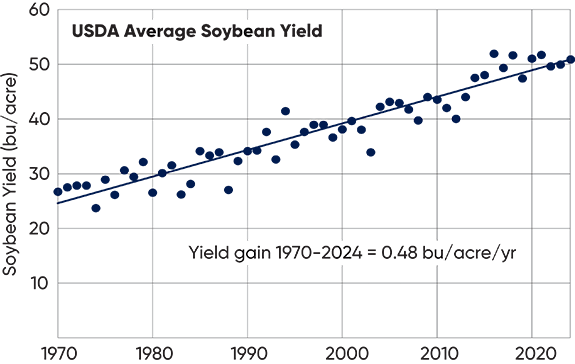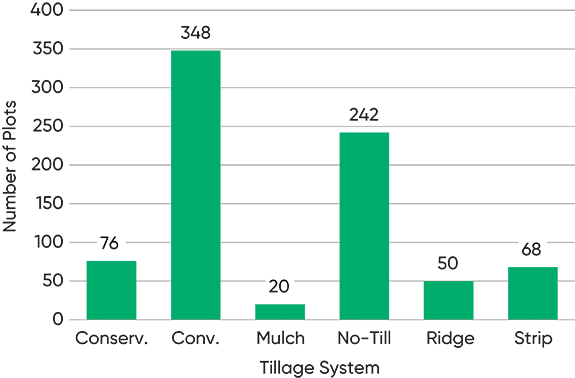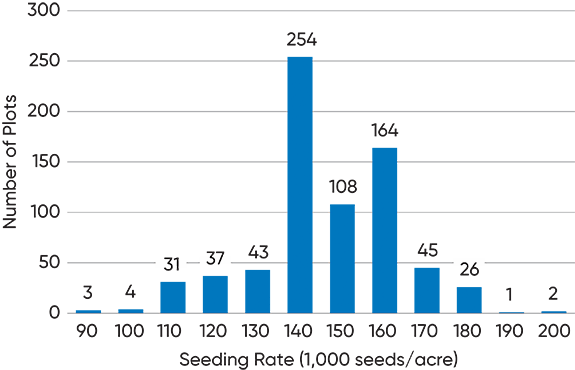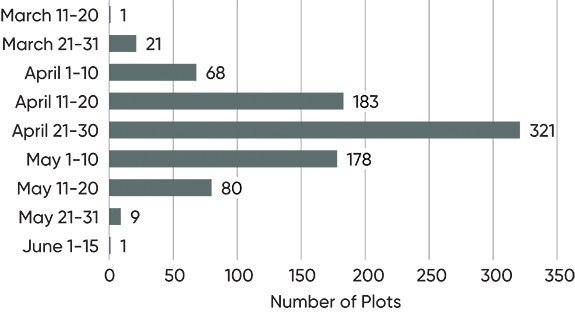Pioneer® brand Z-Series soybeans is what’s next in soybean farming – better yield, better agronomics and better disease and pest protection make this our best soybeans yet. See why we’re the #1 soybean brand in the United States and get ready for the era of more.
Z-Series Soybeans5/22/2025
Achieving 100 bu/acre Yields in Soybeans

Crop Focus
Written by Mark Jeschke, Ph.D., Pioneer Agronomy Manager
Key Points
- A total of 381 Pioneer on-farm soybean trial entries in the U.S. and Canada exceeded 100 bu/acre in 2024, a new record high.
- 100 bu/acre was achieved with numerous different soybean varieties across a wide range of maturities.
- Over 2/3 of 100 bu/acre entries were planted to a new Pioneer® brand Z-Series soybean variety.
- 100 bu/acre yields were achieved across a range of different environments and agronomic practices.

A generational leap for soybeans.





Following burndown, Enlist Duo® and Enlist One® herbicides with Colex-D® technology are the only herbicides containing 2,4-D that are authorized for preemergence and postemergence use with Enlist® crops. Consult Enlist® herbicide labels for weed species controlled. Enlist Duo and Enlist One herbicides are not registered for use or sale in all states and counties; are not registered in AK, CA, CT, HI, ID, MA, ME, MT, NH, NV, OR, RI, UT, VT, WA and WY; and have additional subcounty restrictions in AL, GA, TN and TX, while existing county restrictions still remain in FL. All users must check “Bulletins Live! Two” no earlier than six months before using Enlist One or Enlist Duo. To obtain “Bulletins,” consult epa.gov/espp/, call 1-844-447-3813, or email ESPP@epa.gov. You must use the “Bulletin” valid for the month and state and county in which Enlist One or Enlist Duo are being applied. Contact your state pesticide regulatory agency if you have questions about the registration status of Enlist® herbicides in your area. ALWAYS READ AND FOLLOW PESTICIDE LABEL DIRECTIONS. IT IS A VIOLATION OF FEDERAL AND STATE LAW TO USE ANY PESTICIDE PRODUCT OTHER THAN IN ACCORDANCE WITH ITS LABELING. ONLY USE FORMULATIONS THAT ARE SPECIFICALLY LABELED FOR SUCH USE IN THE STATE OF APPLICATION. USE OF PESTICIDE PRODUCTS, INCLUDING, WITHOUT LIMITATION, 2,4-D-CONTAINING PRODUCTS NOT AUTHORIZED FOR USE WITH ENLIST CROPS, MAY RESULT IN OFF-TARGET DAMAGE TO SENSITIVE CROPS/AREAS AND/OR SUSCEPTIBLE PLANTS, IN ADDITION TO CIVIL AND/OR CRIMINAL PENALTIES. Additional product-specific stewardship requirements for Enlist crops, including the Enlist Product Use Guide, can be found at www.traitstewardship.com.
Always follow stewardship practices in accordance with the Product Use Guide (PUG) or other product-specific stewardship requirements including grain marketing and pesticide label directions. Varieties with BOLT® technology provide excellent plant-back flexibility for soybeans following application of sulfonylurea (SU) herbicides as a component of a burndown program or for double-crop soybeans following SU herbicides applied to wheat the previous fall.
DO NOT APPLY DICAMBA HERBICIDE IN-CROP TO SOYBEANS WITH Roundup Ready 2 Xtend® technology unless you use a dicamba herbicide product that is specifically labeled for that use in the location where you intend to make the application. IT IS A VIOLATION OF FEDERAL AND STATE LAW TO MAKE AN IN-CROP APPLICATION OF ANY DICAMBA HERBICIDE PRODUCT ON SOYBEANS WITH Roundup Ready 2 Xtend® technology, OR ANY OTHER PESTICIDE APPLICATION, UNLESS THE PRODUCT LABELING SPECIFICALLY AUTHORIZES THE USE. Contact the U.S. EPA and your state pesticide regulatory agency with any questions about the approval status of dicamba herbicide products for in-crop use with soybeans with Roundup Ready 2 Xtend® technology.
ALWAYS READ AND FOLLOW PESTICIDE LABEL DIRECTIONS. Soybeans with Roundup Ready 2 Xtend® technology contain genes that confer tolerance to glyphosate and dicamba. Glyphosate herbicides will kill crops that are not tolerant to glyphosate. Dicamba will kill crops that are not tolerant to dicamba.
IMPORTANT NOTICE: No dicamba herbicide has been approved for use in-crop with seed containing Roundup Ready® Xtend Technology for the 2025 spray season at this time. No dicamba herbicide may be used in-crop with this seed unless and until such use is approved or specifically permitted.
Corteva Agriscience is a member of Excellence Through Stewardship® (ETS). Corteva Agriscience products are commercialized in accordance with ETS Product Launch Stewardship Guidance and in compliance with the Corteva Agriscience policies regarding stewardship of those products. In line with these guidelines, our product launch process for responsible launches of new products includes a longstanding process to evaluate export market information, value chain consultations, and regulatory functionality. Growers and end-users must take all steps within their control to follow appropriate stewardship requirements and confirm their buyer’s acceptance of the grain or other material being purchased. For more detailed information on the status of a trait or stack, please visit www.biotradestatus.com.
STS® APPROVED HERBICIDE STATEMENT: This variety contains a trait providing enhanced tolerance to labeled specific sulfonylurea soybean herbicides. The STS® gene will not safeguard this variety against other herbicide chemistries which are labeled to be used only over-the-top of crops that have a different and specified herbicide resistant gene. Always read and follow herbicide directions prior to use. Not all herbicides are registered for sale or use in all states or counties in the United States or all provinces in Canada. Contact your local regulatory agency to determine if a product is registered for sale or use in your area. Always read and follow label directions. ACCIDENTAL APPLICATION OF INCOMPATIBLE HERBICIDES TO THIS VARIETY COULD RESULT IN TOTAL CROP LOSS. YOU MUST SIGN A TECHNOLOGY USE AGREEMENT AND READ THE PRODUCT USE GUIDE PRIOR TO PLANTING. The purchase of these seeds includes a limited license to produce a single soybean crop in the United States (or other applicable country). The use of seed from such a crop or the progeny thereof for propagation or seed multiplication or for production or development of a hybrid or different variety of seed is strictly prohibited. Resale or transfer of the seed is strictly prohibited.
LL - Contains the LibertyLink® gene for resistance to glufosinate.
Roundup Ready 2 Xtend® is a registered trademark of Bayer Group used under license. The transgenic soybean event in Enlist E3® soybeans is jointly developed and owned by Corteva Agriscience and M.S. Technologies L.L.C. LibertyLink® and the Water Droplet Design are registered trademarks of BASF.
The foregoing is provided for informational use only. Please contact your Pioneer sales professional for information and suggestions specific to your operation. Product performance is variable and depends on many factors such as moisture and heat stress, soil type, management practices and environmental stress as well as disease and pest pressures. Individual results may vary. Pioneer® brand products are provided subject to the terms and conditions of purchase which are part of the labeling and purchase documents.





